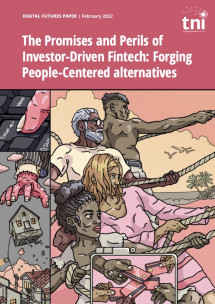Ideas into movement
Boost TNI's work
50 years. Hundreds of social struggles. Countless ideas turned into movement.
Support us as we celebrate our 50th anniversary in 2024.

Financial technology, or ‘fintech’, is a widely celebrated recent innovation. However, in this paper we explore how its seductive narrative is a fundamentally flawed and inaccurate portrayal of the emerging reality. While it is clear that fintech offers a major opportunity to improve the lives of the poor if done right, and it has had some important initial successes, its full long-term impact looks far less rosy.

Download the full paper here.
This paper examines the spectacular rise of ‘fintech’ (financial technology), an innovation that constitues an historic discontinuity in the structure, operations and conduct of financial systems everywhere. The aim is to provide a much-needed corrective to the rapidly proliferating myths and falsehoods surrounding the capacity of fintech to address poverty and promote sustainable and equitable local economic and social development in Low- and Middle-Income Countries (L&MICs) by extending ‘financial inclusion’.
We point out that the basic fintech model is actually an ‘investor-driven’ fintech model that has evolved to overwhelmingly serve the private enrichment and ideological agendas of a narrow global elite composed of venture capitalists and leading investment institutions, the world’s major financial, telecom and digital payments corporations, the main international development agencies (especially the World Bank), well-financed digital advocacy bodies (notably the Bill and Melinda Gates Foundation), the major consultancy companies, and several leading governments in the advanced countries. We argue that the fintech model is being ‘sold’ to governments in the L&MICs on the basis of an almost entirely false premise – that it will deliver major economic and social benefits to all citizens – when the evidence suggests otherwise.
The poor have undoubtedly enjoyed many initial gains as a result of the spread of fintech applications, including reduced costs of, and greater access to, many important financial services. These are not inconsequential benefits. However, like many financial innovations, the initial gains for the poor in L&MICs are increasingly being offset into the medium-to-longer-term by a number of developments that work to undermine and block poverty reduction and sustainable local economic development.
These developments include:
We end the paper by briefly discussing the potential of a practical alternative to the dominant investor-driven fintech model. The experience of a ‘popular fintech’ model that has been deployed since the mid-2010s in the city of Maricá in south-eastern Brazil shows how it is possible for basic fintech applications to be directly used to promote the common good. Piloted by the city government and involving a community digital currency, the Mumbuca, that is managed by the city-owned community development bank, the Mumbuca Bank, the emerging ‘Maricá Model’ has deployed basic fintech applications in such a way as to substantively address local poverty and rising inequality, promote sustainable local enterprise development, extend social justice through the retention and reinvestment of community-based wealth, and to enhance democratic participation in economic life. Maricá’s ‘people’s fintech’ model provides numerous pointers as to how governments in the L&MICs might deploy and manage basic fintech services on behalf of the many and not just the few.
Ilustration by Zoran Svilar